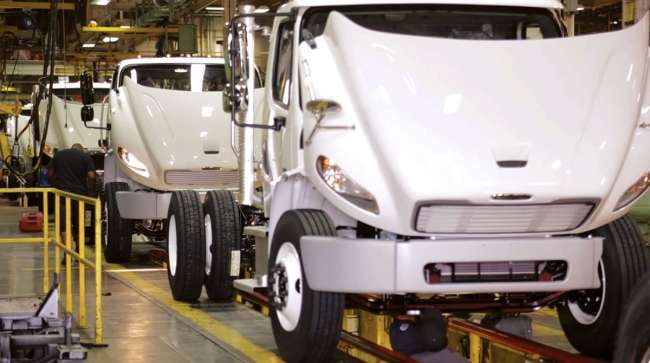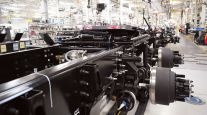Senior Reporter
Class 8 Orders Clear 25,000 in June

[Stay on top of transportation news: Get TTNews in your inbox.]
Class 8 orders in June cleared 25,000 and bounced 61% higher than those placed a year earlier during the pandemic, ACT Research reported, citing truck makers’ preliminary data.
Orders reached 25,700 — the highest level since June 2018 — compared with 16,000 in the 2020 period.
“I would say June was a little bit better than our expectations, and that’s because we believe one of the truck makers opened up its [2022 order] books early. That’s what drove the incremental volume above May’s 22,900,” ACT Vice President Steve Tam told Transport Topics.

Tam
Orders for the first six months reached the third-highest total ever, 208,707, according to ACT — underscoring the prolonged hunger for new trucks so far in 2021.
A year earlier, Class 8 orders in the first half totaled 65,827.
Such a comparison may not seem fair, “but that’s what happened,” Tam said.
First-half 2021 orders trailed only the record of 248,669 set in 2018 and the second-best volume of 221,822 in 2006.
FTR pegged preliminary net orders at 26,700.

Ake
Don Ake, vice president of commercial vehicles for FTR, agreed that it looks like some 2022 orders were included in June’s volume as fleets snatched up the remaining build slots in 2021.
“I don’t see how we don’t hit a record in orders when they all finally open up the order boards,” he said. “There is just that much pent-up demand out there for orders and build slots — and then for trucks — since production continues to run behind.”
That order record could arrive in July, he said.
One fleet executive said freight demand is as strong as he had ever seen it in his 20 years in trucking.

Matthews
“We have a lot of shippers from all different markets trying to source capacity,” Brian Matthews, vice president of operations for American Central Transport Inc., told TT. “Backhaul markets are stronger than in recent memory, too. We are paying close attention to freight that gets our drivers home, that gets them the miles, and more from the drop-and-hook customers — stuff the drivers like.”
He added, “Shippers that are flexible and have those things are very important to our business right now.”
Matthews said the Kansas City, Mo.-based truckload carrier is scheduled to place an order for new trucks in the third quarter as part of its normal replacement cycle. The company operates about 325 heavy-duty trucks.
At the same time, American Trucking Associations Chief Economist Bob Costello told TT there is evidence that many truckload carriers are shrinking despite buying new trucks.

Costello
“Some are trading in or selling more than they are buying,” he said. “Freight is good, for sure, especially retail freight, but I think they are buying new trucks for driver recruitment.”
Matthews said he expected publicly traded carriers reporting Q2 results will have smaller fleets than they had in the first quarter.
“Sourcing drivers is the most difficult we have ever seen,” he said.
He linked the driver shortage to the federal drug and alcohol clearinghouse, a database that holds the names of about 60,000 ineligible drivers, he said. Other drivers have retired early or moved on to other things amid the pandemic.
“Fleets are competing for what’s out there, and there are just not enough drivers to go around and meet everybody’s needs based on the amount of trucks in service,” he said. “That’s why I think we are going to see fleets rightsize to the size of the available driver market.”
Preliminary NA Class 8 net orders in June were 25,700 units, up 11% from May, and a still robust 61% higher than June of 2020’s COVID-impacted intake. https://t.co/zzUE8ttMGW#truck #semitruck #trucking #transportation pic.twitter.com/JEsjV7jQUa — ACT Research (@actresearch) July 7, 2021
ACT took a macro perspective and reported the total demand for U.S. Class 8 active trucks (15 years and younger) in 2020 reached 2.27 million. By the end of this year, it is slated to reach 2.29 million — an increase of 18,000, or a less than 1% increase in size of the total fleet.
“Not huge growth,” Tam said, but growth nonetheless.
The company adjusts for the truckload sector, he noted.

How do you care for your tires? Host Michael Freeze sets out to answer what factors fleets should consider when investing in TPMS and ATIS. He's joined by Matt Wilson of Hendrickson. Hear a snippet above, and get the full program by going to RoadSigns.TTNews.com.
“We have a slightly different measure for the over-the-road segment,” Tam said. “We actually look at 11-year-old trucks. At the end of 2020, that population was at 1.4 million. We believe that will be 1.48 million at the end of 2021, a gain of 80,000.”
So, while some fleets may shrink, Tam said, “Collectively, we are going in the other direction.”
Plus, the current environment is challenging, Ake noted.
“Everybody now is under stress,” he said. “And it’s going to take an extended time to catch up [to demand for trucks]. Orders are in a tremendous up cycle, but look at truck production, things are mild, not anything impressive. That’s the disconnect — and the disconnect is the [disrupted] supply chain.”
Want more news? Listen to today's daily briefing below or go here for more info:




